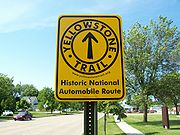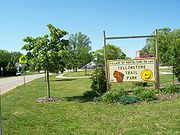
Yellowstone Trail
Encyclopedia


Massachusetts
The Commonwealth of Massachusetts is a state in the New England region of the northeastern United States of America. It is bordered by Rhode Island and Connecticut to the south, New York to the west, and Vermont and New Hampshire to the north; at its east lies the Atlantic Ocean. As of the 2010...
to Seattle. It was conceived by J.W. Parmley of Ipswich, South Dakota
Ipswich, South Dakota
Ipswich is a city in Edmunds County, South Dakota, United States. The population was 954 at the 2010 census. It is the county seat of Edmunds County.-Geography:Ipswich is located at ....
in 1912. Originally, Parmley and his business colleagues wanted a good road from Ipswich to Aberdeen, South Dakota
Aberdeen, South Dakota
Aberdeen is a city in and the county seat of Brown County, South Dakota, United States, about 125 mi northeast of Pierre. Settled in 1880, it was incorporated in 1882. The city population was 26,091 at the 2010 census. The American News is the local newspaper...
, 25 miles (40.2 km) away. In a few weeks the intent had expanded to include a good road to a popular tourist destination, Yellowstone National Park
Yellowstone National Park
Yellowstone National Park, established by the U.S. Congress and signed into law by President Ulysses S. Grant on March 1, 1872, is a national park located primarily in the U.S. state of Wyoming, although it also extends into Montana and Idaho...
.
The automobile was just becoming popular, but there were few good, all weather roads, no useful long distance roads and no government marked routes. The federal government was not interested in building roads, except for the National Pike from Washington D.C. to the Mississippi River
Mississippi River
The Mississippi River is the largest river system in North America. Flowing entirely in the United States, this river rises in western Minnesota and meanders slowly southwards for to the Mississippi River Delta at the Gulf of Mexico. With its many tributaries, the Mississippi's watershed drains...
in the nineteenth century. In other cases, detractors felt that “internal improvements” were unconstitutional. The Yellowstone Trail developed in parallel with the nationwide effort for internal improvements
Internal improvements
Internal improvements is the term used historically in the United States for public works from the end of the American Revolution through much of the 19th century, mainly for the creation of a transportation infrastructure: roads, turnpikes, canals, harbors and navigation improvements...
, which included building and improving roads, as did 250 other named roads. All but two of those other routes were smaller and non-transcontinental in length.

The Yellowstone Trail Association persisted acted much as the AAA
American Automobile Association
AAA , formerly known as the American Automobile Association, is a federation of 51 independently operated motor clubs throughout North America. AAA is a not-for-profit member service organization with more than 51 million members. AAA provides services to its members such as travel, automotive,...
does today. They published maps and brochures, established information bureaus in busy hotels, and set up tents along busy places on the Trail to hand out these materials. People telephoned the Trail Association before they planned a trip to see what roads were passable. These bureaus also provided local information, much as Convention and Visitors Bureaus do today.
In June 1915, a relay race against time was held on the Trail from Chicago
Chicago
Chicago is the largest city in the US state of Illinois. With nearly 2.7 million residents, it is the most populous city in the Midwestern United States and the third most populous in the US, after New York City and Los Angeles...
to Seattle in 97 hours. There were no deaths in those 2445 miles (3,934.8 km), but one of several accidents happened in Eau Claire, Wisconsin
Eau Claire, Wisconsin
Eau Claire is a city located in the west-central part of the U.S. state of Wisconsin. The population was 65,883 as of the 2010 census, making it the largest municipality in the northwestern portion of the state, and the 9th largest in the state overall. It is the county seat of Eau Claire County,...
. George Murphy was driving his Mitchell 6 from nearby Chippewa Falls
Chippewa Falls, Wisconsin
Chippewa Falls is a city located on the Chippewa River in Chippewa County in the U.S. state of Wisconsin. The population was 13,661 at the 2010 census. Incorporated as a city in 1869, it is the county seat of Chippewa County....
, speeding recklessly at 26 mi/h, when he skidded coming around the corner and down the hill from Germania Street to Madison Street. He crashed into a tree but survived. The backup or “trailer” car finished George’s allotted distance to Menomonie
Menomonie, Wisconsin
Two other spellings of the name appear elsewhere, see Menomonee and Menominee. For the town, see Menomonie .Menomonie is a city in and the county seat of Dunn County in the western part of the U.S. state of Wisconsin. The city's population was 16,264 as of the 2010 census...
.
After the Great Depression
Great Depression
The Great Depression was a severe worldwide economic depression in the decade preceding World War II. The timing of the Great Depression varied across nations, but in most countries it started in about 1929 and lasted until the late 1930s or early 1940s...
, the Yellowstone Trail and other named trails lost their allure. Its major influence died in 1929-30 with the original Yellowstone Trail Association. A replacement organization, Yellowstone Highway Association, operated marginally until about 1939.
In the eastern United States
Eastern United States
The Eastern United States, the American East, or simply the East is traditionally defined as the states east of the Mississippi River. The first two tiers of states west of the Mississippi have traditionally been considered part of the West, but can be included in the East today; usually in...
, the Yellowstone Trail Association had little influence on road building and functioned primarily as a travel bureau, enticing tourists west along the Trail. A few streets and roads in the East retain the Yellowstone Trail name, and some sections of the Trail are still gravel roads, but the road markers and the Yellowstone Trail Garages are gone.

